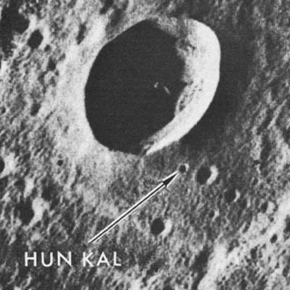Hun Kal (crater)
 Hun Kal is indicated by the arrow. | |
| Feature type | Impact crater |
|---|---|
| Location | Kuiper quadrangle, Mercury |
| Coordinates | 0°28′S 20°01′W / 0.46°S 20.01°W |
| Diameter | 1.13 km (0.70 mi) |
| Eponym | '20' in the Mayan language |
Hun Kal is a small (about 1.5 km in diameter) crater on Mercury that serves as the reference point for the planet's system of longitude. The longitude of Hun Kal's center is defined as being 20° W, thus establishing the planet's prime meridian.[1] The name "Hun Kal" means '20' in the language of the Maya.[2]
Hun Kal was chosen as a reference point since the actual prime meridian was in shadow when Mariner 10 photographed the region, hiding any features near 0° longitude from view.
The prime meridian of Mercury is thermocentric, it runs through the point on the equator where the planet is hottest (due to the planet's rotation and orbit, the sun briefly retrogrades at noon at this point during perihelion, giving it more sun).[3][4][5]
The large crater in which Hun Kal lies is not named. To the northwest is Al-Jāhiz crater, and to the west is Lu Hsun crater.
-
This Mariner 10 image shows the surrounding context of Hun Kal, which is almost invisibly tiny near the center.
-
MESSENGER NAC image with Hun Kal at center
References
[edit]- ^ "USGS Astrogeology: Rotation and pole position for the Sun and planets (IAU WGCCRE)". Archived from the original on 24 October 2011. Retrieved 22 October 2009.
- ^ "Hun Kal". Gazetteer of Planetary Nomenclature. USGS Astrogeology Research Program.
- ^ Davies, M. E., "Surface Coordinates and Cartography of Mercury," Journal of Geophysical Research, Vol. 80, No. 17, June 10, 1975.
- ^ Archinal, Brent A.; A'Hearn, Michael F.; Bowell, Edward L.; Conrad, Albert R.; et al. (2010). "Report of the IAU Working Group on Cartographic Coordinates and Rotational Elements: 2009". Celestial Mechanics and Dynamical Astronomy. 109 (2): 101–135. Bibcode:2011CeMDA.109..101A. doi:10.1007/s10569-010-9320-4. ISSN 0923-2958. S2CID 189842666.
- ^ "USGS Astrogeology: Rotation and pole position for the Sun and planets (IAU WGCCRE)". Archived from the original on October 24, 2011. Retrieved October 22, 2009.


